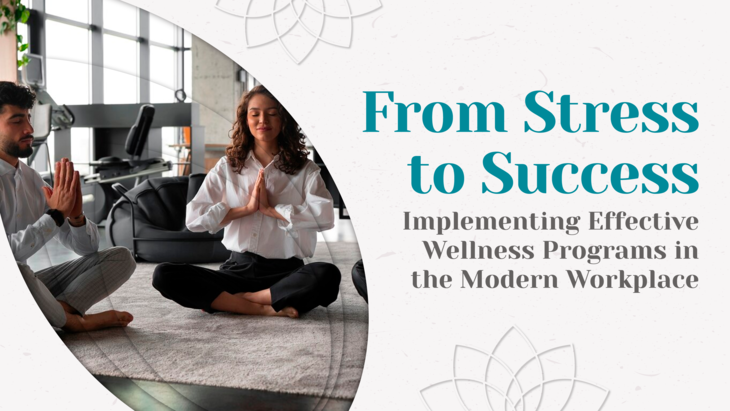In the 21st-century corporate landscape, prioritizing employee well-being has become paramount. More than just a passing trend, the workplace wellness revolution signifies a paradigm shift, acknowledging the intrinsic link between employee health and organizational triumph. As we navigate the intricacies of modern work environments, fostering a culture that values and nurtures the well-being of employees is not just a choice; it's a strategic imperative. Join us on this journey as we explore the transformative impact of the workplace wellness revolution, unveiling the strategies, innovations, and insights that are reshaping the way we work and thrive together.
The Evolution of Workplace Wellness
The journey of workplace wellness is a fascinating evolution, marked by a shift from routine health checkups to a holistic approach that encompasses mental well-being. In this transformative landscape, the interconnectedness of physical and mental health takes center stage, underscoring the understanding that a healthy workforce is a resilient and thriving one. This paradigm shift is not merely a trend but a fundamental change in how organizations perceive and prioritize the well-being of their employees.
In tandem with this evolution, workplace wellness therapy trends are veering towards a more inclusive model. Companies are awakening to the realization that employee well-being extends beyond physical health. Addressing mental health in the workplace has become a pivotal focus, reflecting a commitment to creating environments that nurture overall well-being. Recognizing the interconnected nature of mind and body, businesses are embracing strategies that go beyond traditional health initiatives, fostering a workplace culture that is supportive and attuned to the holistic needs of its workforce.
Looking ahead to 2024, the workplace wellness revolution takes a quantum leap with a distinct emphasis on mental health. Organizations are proactively adopting strategies tailored to reduce stress levels, promote a harmonious work-life balance, and establish spaces where employees feel not just seen but genuinely supported on their mental health journeys. This forward-thinking approach acknowledges that a mentally resilient workforce is not only happier but also more productive, laying the foundation for a workplace that values the holistic well-being of its most valuable asset—its people.
AI-Driven Wellness: Personalized Plans and Ethical Considerations
In the contemporary landscape of workplace wellness, the integration of artificial intelligence (AI) has emerged as a transformative force. The role of AI in shaping employee wellness programs is pivotal, with AI algorithms delving into individual health data. This advanced analysis enables the creation of personalized wellness plans, taking into account crucial factors such as stress levels, sleep patterns, and fitness goals.
The beauty of AI lies in its capability to go beyond generic recommendations. With AI-driven personalized plans, employees experience a tailored approach to wellness. These plans are meticulously crafted to address each individual's unique health needs, fostering a sense of empowerment and engagement in their well-being journey.
While the benefits of AI in wellness programs are evident in enhanced personalization and effectiveness, challenges such as data privacy concerns and ethical considerations loom. Striking the right balance is imperative for organizations committed to leveraging AI for employee well-being, ensuring that the advantages of this technological integration are maximized while maintaining the utmost respect for privacy and ethical standards.
Elevating Workforce Vitality: Office Fitness Revolution
In the contemporary corporate landscape, the paradigm of office life is undergoing a transformative shift, with innovative fitness initiatives taking center stage. No longer confined to sedentary routines, forward-thinking companies are revolutionizing the workplace by incorporating fitness programs. From invigorating yoga sessions to the convenience of in-office gyms, these initiatives are redefining the traditional office setup. This evolution is not merely a response to the call for a healthier lifestyle but a strategic move towards creating a workplace that values the holistic well-being of its employees.
The positive impact on employee health is profound and multifaceted. Regular engagement in physical activity not only diminishes the risk of chronic diseases but also acts as a mood enhancer, fostering a more positive and energetic workforce. Beyond the obvious health benefits, these fitness initiatives play a pivotal role in fostering a sense of community and shared wellness goals among employees, creating an environment where everyone is invested in each other's well-being.
Real-world success stories attest to the effectiveness of these initiatives. Examples of successful fitness programs abound, ranging from interactive step challenges that infuse an element of friendly competition to the provision of standing desks that encourage movement throughout the workday. Group workout sessions further strengthen the sense of camaraderie, making wellness a collective journey. These tangible implementations not only contribute to individual health but collectively shape a workplace culture that prioritizes the vitality and well-being of its workforce.
Fueling Productivity: Employee Nutrition Workshops
Organizations are increasingly recognizing the pivotal role that nutrition workshops play in fostering healthier and more productive work environments. These workshops, carefully designed for the specific needs of employees, offer a unique opportunity for individuals to enhance their understanding of nutrition and make informed choices for a healthier lifestyle.
Engaging and informative, these workshops go beyond the conventional approach to dietary education. They incorporate interactive sessions, cooking demonstrations, and Q&A segments, creating an environment where employees actively participate and learn. The emphasis is not only on imparting knowledge but also on encouraging healthy eating habits that can be seamlessly integrated into the fast-paced corporate routine.
By investing in nutrition workshops for employees, organizations demonstrate a commitment to the well-being of their workforce. Beyond the immediate benefits of improved energy levels and overall health, these workshops contribute to a positive workplace culture, fostering a community that values and prioritizes the health and nutrition of its members. In an era where employee wellness is a cornerstone of organizational success, nutrition workshops emerge as a strategic initiative that not only nurtures individual health but also cultivates a thriving and engaged workforce.
Future Wellness: Tech Integration, VR Fitness, Work-Life Harmony
The future trends in workplace wellness are poised to redefine the way organizations prioritize employee health. Innovative technologies will play a pivotal role, with a surge in the integration of artificial intelligence (AI) to tailor personalized wellness plans for employees. This not only enhances the precision of health interventions but also underscores a shift toward a more holistic approach, acknowledging the intricate connection between physical and mental well-being.
Furthermore, the landscape of workplace fitness is set to undergo a revolution, with virtual reality (VR) in fitness programs taking center stage. VR applications will transform traditional workout routines into immersive and engaging experiences, fostering a sense of enjoyment that encourages consistent participation. As organizations recognize the impact of employee health on overall productivity, the adoption of VR in fitness programs emerges as a forward-thinking strategy to promote regular exercise and boost overall well-being.
Beyond technology, the future of workplace wellness will witness a deeper commitment to fostering a culture of work-life balance. Organizations will prioritize policies that allow flexibility, remote work options, and clear boundaries, aiming to create environments where employees can thrive both professionally and personally. This evolution in workplace wellness reflects a profound understanding that a healthy and balanced workforce is not just an asset but a cornerstone for sustained success in the dynamic landscape of the 21st century.
Maximizing Employee Engagement: Strategies for Success
Implementing effective strategies for employee engagement is a pivotal factor in driving organizational success. Employee engagement goes beyond mere participation; it's about fostering a deep connection and commitment from each team member. One key strategy involves creating a workplace culture that prioritizes open communication, transparency, and recognition. When employees feel heard and valued, their level of engagement naturally rises. Encouraging a sense of ownership and involvement is another critical aspect. This entails empowering employees to actively contribute ideas, take on responsibilities, and play a meaningful role in the decision-making processes, instilling a sense of pride and responsibility in their work.
Recognition programs are powerful tools in boosting employee engagement. Acknowledging and appreciating employees' contributions, whether big or small, creates a positive work environment. This can include regular shout-outs, awards, or incentive programs that highlight individual and team accomplishments. Additionally, fostering a sense of community within the workplace enhances engagement. Team-building activities, mentorship programs, and collaborative projects all contribute to creating a supportive and cohesive work environment. When employees feel connected to their colleagues and the broader organizational goals, it strengthens their commitment and sense of belonging, driving overall employee engagement.
Moreover, providing opportunities for professional development is a strategic approach to enhance employee engagement. Investing in training programs, workshops, and mentorship opportunities not only equips employees with valuable skills but also communicates a commitment to their growth. By aligning personal and professional goals with the company's mission, organizations create a shared sense of purpose that fuels sustained employee engagement. In essence, these multifaceted strategies underscore the importance of a holistic and proactive approach to employee engagement in fostering a thriving and motivated workforce.
Harmony at Work: Mastering Life-Work Balance
The concept of work-life balance encapsulates the pursuit of equilibrium, where individuals can excel in their careers without compromising their quality of life. It's an intricate dance, requiring individuals to navigate deadlines and meetings while ensuring they have ample time for personal pursuits and cherished relationships.
Striking the right balance involves recognizing the significance of setting boundaries. Establishing clear limits on working hours, delineating personal and professional spaces, and learning to switch off from work-related concerns during designated off-hours are crucial components. Moreover, organizations play a pivotal role in fostering a culture that values work-life balance, offering flexible work arrangements and supportive policies that empower employees to manage their professional and personal spheres effectively.
The impact of a well-maintained work-life balance extends beyond individual well-being; it significantly influences overall job satisfaction and, consequently, productivity. Employees who feel a sense of control over their time and can engage in activities outside of work report higher levels of job satisfaction. In essence, achieving a harmonious balance between work and life is not just an individual pursuit; it's a collective endeavor that requires the commitment of both individuals and organizations to create environments where everyone can thrive both professionally and personally.
Tech-Driven Workplace Health: A Paradigm for Well-Being
The integration of emerging technologies is reshaping the traditional approach to employee health. From sophisticated wearable devices to cutting-edge sensors, organizations are leveraging advanced tools to proactively monitor and enhance the well-being of their workforce. These technologies provide real-time insights into crucial health metrics, enabling a personalized and targeted approach to employee wellness. As a result, the workplace is no longer just a physical space; it's a hub of innovation where technology plays a pivotal role in fostering a healthier and more productive environment.
One key player in this technological evolution is the utilization of wearable devices. These compact gadgets, ranging from smartwatches to fitness trackers, enable continuous monitoring of physical activity, sleep patterns, and even stress levels. The data collected from these wearables empowers both employees and employers with valuable information, fostering a culture of preventive health measures. With a focus on personalized interventions, organizations can tailor wellness programs to individual needs, thereby maximizing the positive impact on employee health.
Additionally, the integration of sensors into the workplace health paradigm adds another layer of sophistication. These sensors can be embedded in various environments to monitor factors such as air quality, lighting, and ergonomic conditions. By creating a workplace that responds to these real-time environmental insights, organizations can further optimize the overall well-being of their employees. The synergy between these emerging technologies and workplace health not only ensures a healthier workforce but also positions organizations at the forefront of a progressive and tech-driven approach to employee wellness.
Boosting Productivity Through Wellness
The pursuit of wellness has transcended mere health initiatives to become a powerful catalyst for boosting productivity. Recognizing that employee well-being is intricately linked to overall performance, organizations are strategically investing in comprehensive wellness programs. These initiatives encompass a spectrum of activities, from promoting physical fitness with on-site gyms and fitness challenges to fostering mental health through mindfulness practices and stress management workshops. By placing a heightened emphasis on employee wellness, companies aim to create a work environment that not only supports individual health but also maximizes workforce efficiency.
The connection between well-being and productivity is more than anecdotal; it's backed by a growing body of research. Numerous studies highlight that employees who actively engage in wellness programs exhibit higher levels of focus, creativity, and job satisfaction. Implementing strategies that directly target productivity, such as designated break areas and wellness initiatives addressing common workplace stressors, contributes to a positive and dynamic work culture. This holistic approach to boosting productivity through wellness goes beyond traditional metrics, emphasizing the value of a healthy, balanced workforce in achieving sustained success.
As organizations navigate the evolving dynamics of the modern workplace, the integration of wellness into corporate strategies is a proactive measure. Beyond the immediate benefits of improved productivity, it fosters a culture that prioritizes employee health, leading to higher retention rates and enhanced employee morale. The synergy between a supportive, wellness-oriented environment and heightened performance is not only a competitive advantage in attracting top talent but also a testament to the forward-thinking nature of organizations that understand the profound impact of investing in their most valuable asset—the well-being of their employees.
Conclusion
In conclusion, the workplace wellness revolution is reshaping corporate cultures in 2024. From the integration of AI in wellness programs to innovative fitness initiatives, organizations are recognizing the pivotal role of employee well-being. The future holds exciting possibilities with emerging technologies and a continued focus on creating supportive, engaging workplace environments.
FAQs
Q1. What are the immediate benefits of a workplace wellness program?
Workplace wellness programs can lead to increased employee productivity, reduced absenteeism, and improved overall job satisfaction.
Q2. How can small businesses implement effective wellness initiatives?
Small businesses can start by assessing employee needs, implementing cost-effective wellness programs, and creating a supportive culture.
Q3. Are there industry-specific considerations for workplace wellness?
Yes, industries may have unique challenges, and wellness programs should be tailored to address specific needs and work environments.
Q4. How do wellness programs contribute to employee retention?
Wellness programs contribute to employee retention by fostering a positive work environment and showing a commitment to employee well-being.
Q5. Can workplace wellness programs be tailored to remote work?
Absolutely, with virtual wellness resources, flexible schedules, and mental health support, companies can extend wellness initiatives to remote employees.






Leave a reply